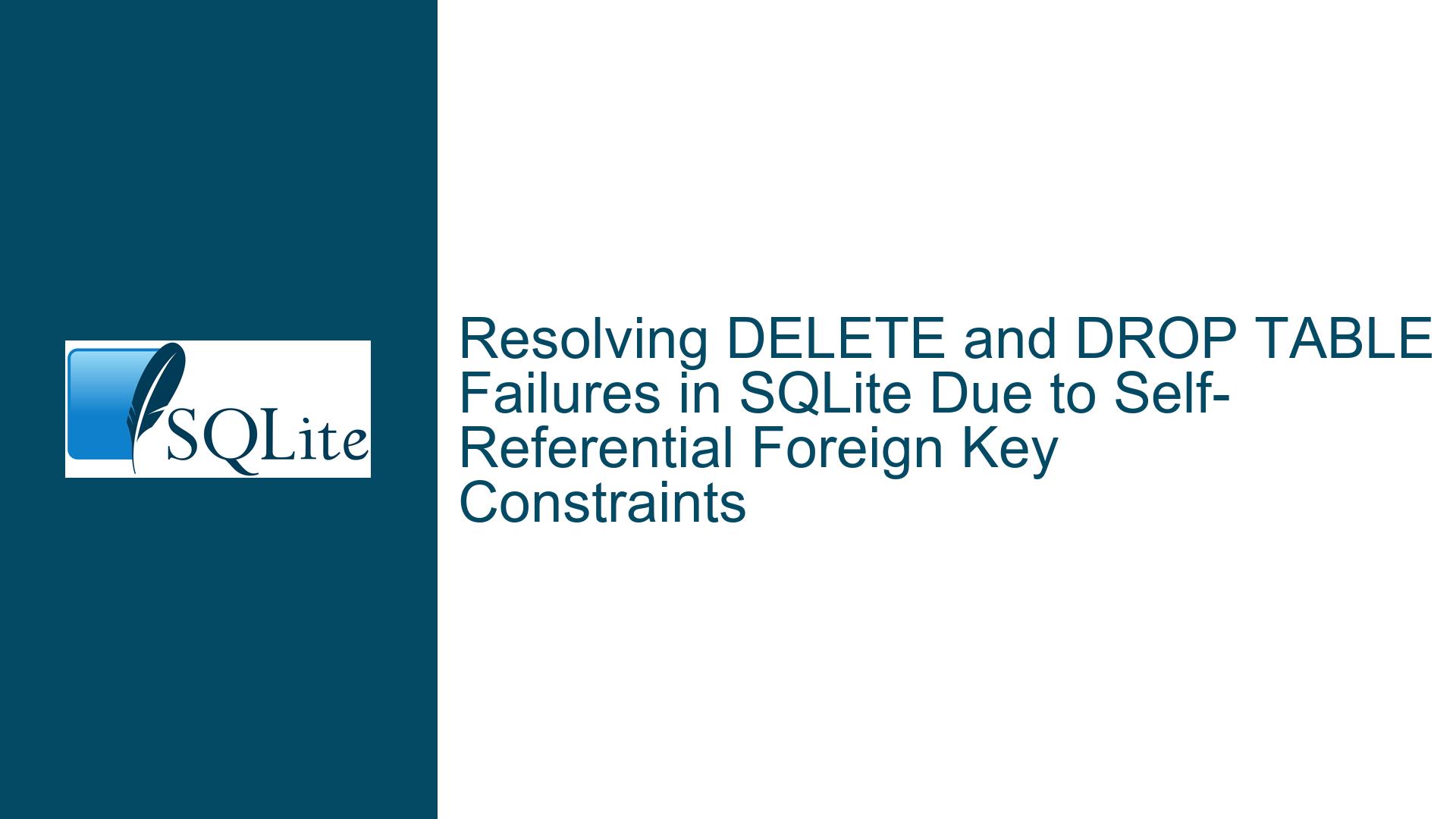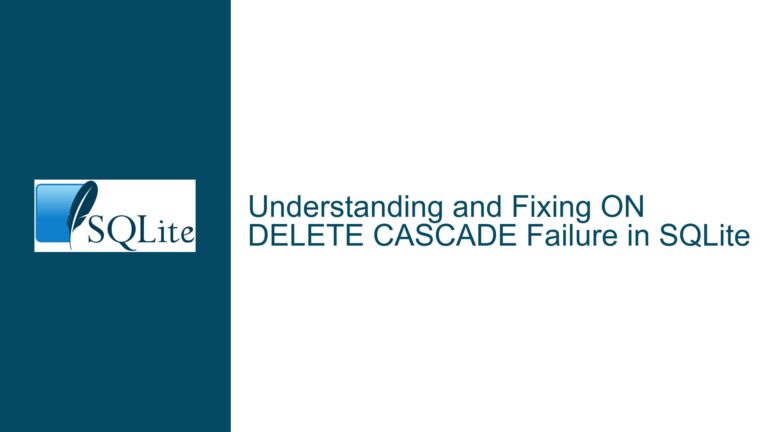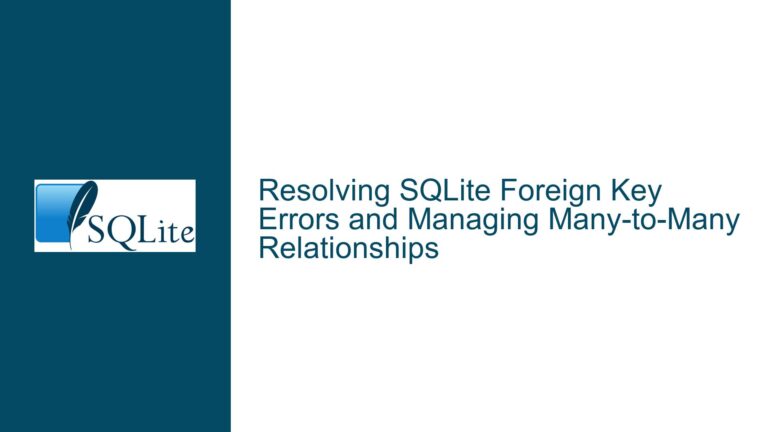Resolving DELETE and DROP TABLE Failures in SQLite Due to Self-Referential Foreign Key Constraints
Understanding Immediate Constraint Enforcement with Self-Referential RESTRICT Foreign Keys
The core issue arises when attempting to delete rows from a table with a self-referential foreign key constraint configured with ON DELETE RESTRICT or dropping the table entirely. SQLite enforces RESTRICT actions immediately during row deletion operations, unlike other database systems that may defer constraint checks until the end of the statement or transaction. This immediate enforcement creates conflicts when parent and child rows reside in the same table and are deleted in a single operation. For example, consider a table foo with the following structure:
CREATE TABLE "foo" (
id INTEGER PRIMARY KEY NOT NULL,
id_parent INTEGER REFERENCES "foo"(id) ON DELETE RESTRICT
);
Inserting rows (1, NULL) and (2, 1) creates a parent-child relationship where row 2 references row 1. Executing DELETE FROM "foo" WHERE id IN (1,2); fails because SQLite processes deletions row-by-row. If row 1 is processed first, the foreign key constraint on row 2 immediately triggers a violation, as row 2 still references row 1. The same principle applies to DROP TABLE "foo";—if any rows remain due to the failed delete operation, the table cannot be dropped because SQLite validates foreign key constraints before allowing structural changes.
This behavior diverges from PostgreSQL and other databases that evaluate constraints after the entire DELETE statement completes. SQLite’s row-by-row processing under RESTRICT exposes a critical dependency on deletion order, which is not guaranteed in bulk operations. Developers expecting atomic constraint validation at the statement level will encounter unexpected errors, necessitating workarounds specific to SQLite’s execution model.
Root Causes of Constraint Violations in Hierarchical Data Deletion
1. Immediate Enforcement of RESTRICT Actions
SQLite’s ON DELETE RESTRICT clause enforces constraints at the moment a parent row is modified or deleted, not at the end of the transaction or statement. This differs from NO ACTION, which delays enforcement until the transaction commits. When deleting multiple rows in a single statement, SQLite does not guarantee an order of operations, making it possible for a parent row to be processed before its dependent child rows. The immediate check then fails because the child row’s foreign key reference becomes invalid.
2. Row-by-Row Processing in DELETE Operations
SQLite’s DELETE operations process rows individually, and the absence of a deterministic order in bulk deletions (e.g., WHERE id IN (1,2)) can lead to parent rows being deleted before their children. This is particularly problematic in self-referential tables where the parent and child reside in the same table. The lack of control over row processing order forces developers to manually sequence deletions or use alternative constraint types.
3. Foreign Key Validation During DROP TABLE
Dropping a table requires SQLite to verify that no foreign key references to the table exist at the moment the DROP TABLE command is executed. If a prior DELETE operation fails to remove all rows due to constraint violations, the table cannot be dropped. This creates a circular dependency: the table cannot be modified until its rows are deleted, but the rows cannot be deleted without violating constraints.
Workarounds for Managing RESTRICT Constraints and Table Deletion
1. Defer Foreign Key Checks Using PRAGMA defer_foreign_keys
Enabling PRAGMA defer_foreign_keys = 1 allows foreign key constraints to be deferred until the transaction commits. This defers all foreign key checks, including those marked as RESTRICT, enabling bulk deletions of parent and child rows in a single transaction. The constraints are validated at commit time, after all rows have been marked for deletion.
Implementation Steps:
- Enable deferred foreign keys and wrap operations in a transaction:
PRAGMA foreign_keys = 1; PRAGMA defer_foreign_keys = 1; BEGIN TRANSACTION; DELETE FROM "foo" WHERE id IN (1,2); DROP TABLE IF EXISTS "foo"; COMMIT; - Ensure all dependent rows are included in the deletion criteria to avoid orphaned references.
Limitations:
- Deferred constraints only apply within an explicit transaction.
- Requires SQLite 3.8.0 or later.
2. Manually Sequence Deletions to Prioritize Child Rows
If deferring constraints is not feasible, explicitly delete child rows before their parents. This requires splitting bulk operations into ordered statements:
-- Delete child row first
DELETE FROM "foo" WHERE id = 2;
-- Then delete parent row
DELETE FROM "foo" WHERE id = 1;
DROP TABLE "foo";
Advantages:
- Works without modifying foreign key configurations.
- Predictable execution order eliminates constraint violations.
Disadvantages:
- Impractical for large datasets or complex hierarchies.
- Requires explicit knowledge of parent-child relationships.
3. Replace RESTRICT with NO ACTION or CASCADE
The RESTRICT action’s immediate enforcement is unique to SQLite. Replacing it with ON DELETE NO ACTION (the default) allows constraints to be deferred, aligning SQLite’s behavior with other databases:
CREATE TABLE "foo" (
id INTEGER PRIMARY KEY NOT NULL,
id_parent INTEGER REFERENCES "foo"(id) ON DELETE NO ACTION
);
Considerations:
NO ACTIONdelays constraint checks until the transaction commits.- Use
ON DELETE CASCADEto automatically delete child rows when a parent is removed.
4. Temporary Disabling of Foreign Key Enforcement
Disabling foreign key checks entirely is a last resort for scenarios where schema modifications are unavoidable:
PRAGMA foreign_keys = 0;
DELETE FROM "foo";
DROP TABLE "foo";
PRAGMA foreign_keys = 1;
Risks:
- Bypasses all foreign key validations, risking data corruption.
- Not recommended for production databases.
5. Use Triggers to Enforce Custom Constraints
Replace foreign key constraints with triggers that implement custom validation logic. This provides full control over constraint enforcement timing:
CREATE TRIGGER prevent_parent_deletion
BEFORE DELETE ON "foo"
FOR EACH ROW
WHEN EXISTS (SELECT 1 FROM "foo" WHERE id_parent = OLD.id)
BEGIN
SELECT RAISE(ABORT, 'Cannot delete parent row with existing children');
END;
Advantages:
- Custom error messages and validation logic.
- Triggers execute within the same transaction, enabling deferred checks.
Disadvantages:
- Increases complexity compared to native foreign keys.
- Requires manual maintenance of trigger logic.
6. Recreate the Table Without RESTRICT Constraints
If the table must be dropped and recreated, temporarily disable foreign keys, drop the table, and rebuild it with revised constraints:
PRAGMA foreign_keys = 0;
DROP TABLE "foo";
CREATE TABLE "foo" (
id INTEGER PRIMARY KEY NOT NULL,
id_parent INTEGER REFERENCES "foo"(id) ON DELETE NO ACTION
);
PRAGMA foreign_keys = 1;
Use Case:
- Ideal for schema migrations or one-time data resets.
Final Recommendation
For most applications, combining PRAGMA defer_foreign_keys with explicit transactions offers the safest and most efficient solution. It respects foreign key constraints while providing the flexibility needed to manage self-referential data. Developers should reserve schema modifications and trigger-based solutions for edge cases where immediate constraint enforcement is non-negotiable.






